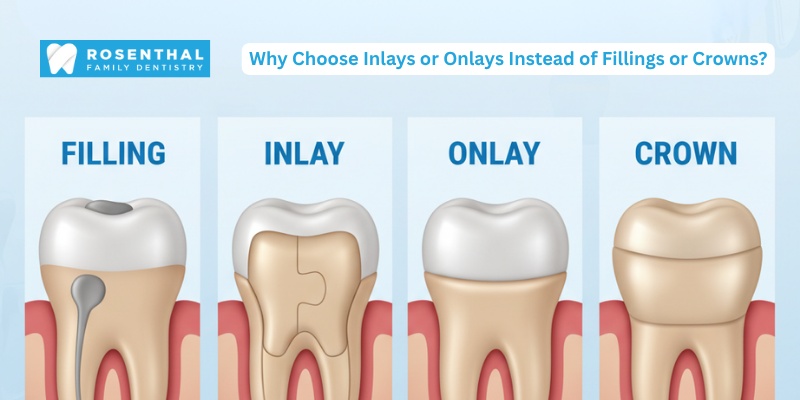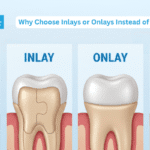I’ll be honest—most people don’t think twice about what kind of dental restoration they get. If something hurts, the goal is simple: fix it and move on. But when your dentist starts explaining options like fillings, crowns, or something called “inlays and onlays,” things can get confusing fast.
A friend of mine recently went through this exact dilemma. She had a cracked tooth that wasn’t bad enough for a full crown but too big for a standard filling. Her dentist suggested an onlay, and she looked at me like, “Is that even a real thing?”
It is. It might be one of the best-kept secrets in modern dentistry.
So, if you’ve ever wondered what inlays and onlays are and why a dentist might recommend them over traditional fillings or crowns, let’s talk about it—in plain, real-world terms.
Why Dentists Love Them (and Why You Might Too)
Dentists like inlays and onlays because they’re strong, long-lasting, and conservative. But what that really means for you is this: less drilling, a better fit, and a more natural-looking smile.
Let’s break that down a bit.
1. They Preserve More of Your Natural Tooth
If you’ve ever had a crown, you know it involves removing a decent amount of healthy tooth structure. The dentist has to file down the entire tooth to make space for the crown that sits on top.
With inlays and onlays, that’s not the case. Your dentist only removes the decayed or damaged portion—nothing more. The rest of your natural tooth stays intact.
That matters because the more of your original tooth structure you keep, the stronger your tooth stays over time.
I remember my cousin saying her dentist called inlays “tooth-savers.” That’s not an exaggeration. They really are designed to protect what’s left instead of replacing everything.
2. They’re Built to Last
Fillings do not last forever, especially those older metal versions. With time, they can wear down, crack, or even fall off the teeth. This can let bacteria sneak back in.
But that’s not the case with inlays and onlays. They are made with high-quality materials like ceramic, porcelain, or composite resin. They will give you great value for your money.
They can last 10–15 years easily—sometimes even longer with good care. That’s much longer than the average filling.
3. They Look and Feel Natural
Nobody wants a mouthful of metal. One of the biggest perks of inlays and onlays is how natural they look.
They’re custom-made to match the exact color and shape of your tooth. Once placed, you honestly can’t tell the difference. Even when you laugh or smile big, they blend right in.
And they don’t just look good—they feel natural too. Because they’re precisely designed, your bite feels normal right away. You won’t get that awkward “something feels off” sensation that sometimes comes with bulky fillings or temporary crowns.
4. They Strengthen Weak Teeth
Here’s something most people don’t realize: a large filling can sometimes weaken a tooth. When too much structure is removed, it leaves thin walls that can eventually crack under pressure.
An inlay, though, acts like a protective shield. It does more than repair the damaged part. It also reinforces the structure of the teeth. So, if you have a weak tooth or one that has an old filling, an onlay can come in handy. It can prevent you from requiring a full crown along the line.
5. They’re a Great Long-Term Investment
Inlays and onlays are on the higher end of the price spectrum when compared to traditional fillings, but they are a better long-term investment. They will last you twice as long as your natural teeth.
Replacing a filling that has cracked or fallen out is not cheap. Those costs can add up. But that’s not the case with inlays and onlays. Once you’ve done it, you’re done.
It’s like buying a good pair of boots instead of cheap ones that you have to replace every season. One good fix now means less worry later.
When Are They the Best Choice?
Here’s when your dentist might suggest an inlay or onlay:
- You’ve got a cavity that’s too big for a filling but not bad enough for a full crown.
- You’ve got an old filling that’s failing, and the tooth needs reinforcement.
- You’ve cracked or chipped a tooth, but most of it is still in good shape.
- You want a strong, natural-looking restoration that lasts.
They’re especially great for molars—the teeth that take the most pressure when you chew.
What’s the Process Like?
The process is simpler than you might think.
Usually, it takes two visits. During the first visit, your dentist removes the decay or old filling, takes a digital or physical impression, and sends it off to a lab. You’ll get a temporary restoration while your custom inlay or onlay is made.
On your second visit, the dentist bonds the new piece securely in place, polishes it, and checks your bite. That’s it. You’re done.
Nowadays, with advanced technology like CAD/CAM systems, some dentists can even make and place your inlay or onlay the same day.
So, Are They Worth It?
If you ask me—and most dentists would agree—yes. Absolutely.
Inlays and onlays strike a perfect balance between strength, preservation, and aesthetics. They protect more of your natural tooth than a crown and last longer than a traditional filling.
My friend, the one who was skeptical at first? Her onlay is still holding up beautifully five years later. She barely remembers which tooth it was. And that’s kind of the point—good dental work should disappear into your smile.
Final Thoughts
Choosing between fillings, crowns, and inlays or onlays isn’t always straightforward, but here’s the best way to think about it:
- Fillings are great for minor repairs.
- Crowns are best when the tooth is badly damaged.
- Inlays and onlays are that perfect middle option—strong, natural-looking, and designed to last.
If your dentist suggests one, they’re probably trying to help you keep as much of your natural tooth as possible—and that’s always a win.
So next time you’re in that chair, don’t tune out when your dentist mentions inlays or onlays. Ask questions. You might find they’re the best fit for your smile—literally and figuratively.





